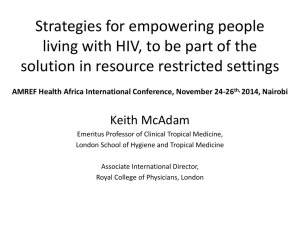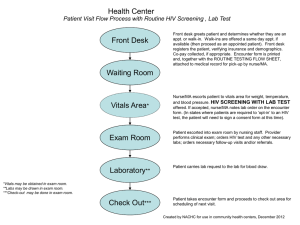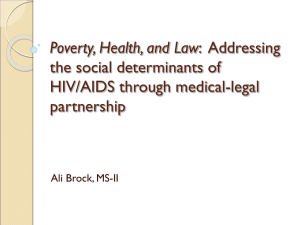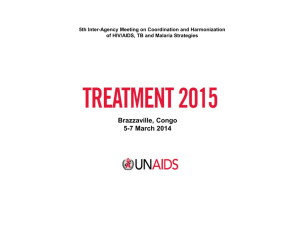TB/HIV Update
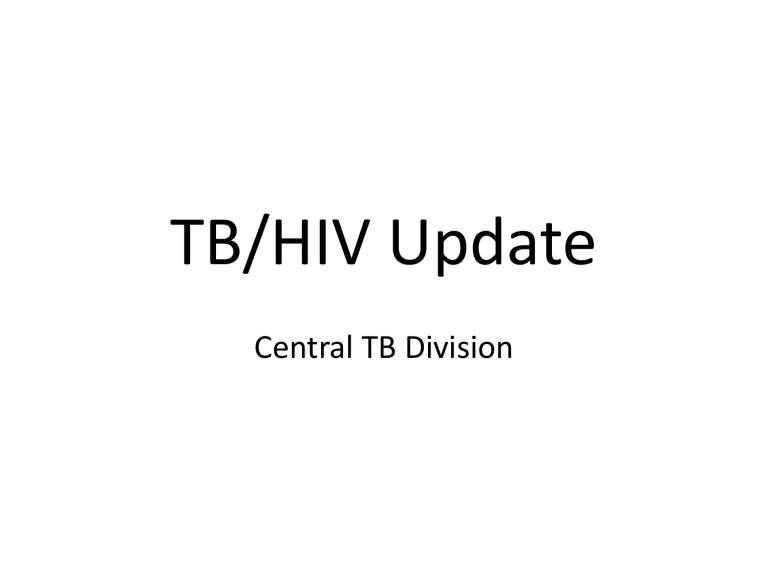
TB/HIV Update
Central TB Division
Estimated HIV prevalence in new TB cases, 2008
National estimate – 4.85% of Incident TB cases are HIV positive
Proportion of Registered TB patients who are HIV+, 1q10
<1%
1%-4.9%
5%-9.9%
>10%
Highly Variable!!
District
BAGALKOT
BELGAUM
BIJAPUR
DHARWAD
GADAG
HAVERI
RNTCP: HIV status among TB patients registered for DOTS
1Q-2Q 2009 Karnataka State
Total TB patient s register ed for
DOTS
No. known to be tested for
HIV (%)
Of the number tested for HIV, no. known to be HIV infected (%)
Minimum % HIV positive among registered TB patients
UTTARA_KANNADA
BIDAR
BELLARY
GULBARGA
KOPPAL
RAICHUR
KARNATAKA
1114 913 82%
2544 1812 71%
1135 790 70%
931
530
750
646
612
332
577
359
66%
63%
77%
56%
856 649 76%
1528 1075 70%
1922 959 50%
877 757 86%
1456 1193 82%
34165 24246 71%
423
493
340
116
54
67
54
66
133
152
134
187
3977
46%
27%
43%
19%
16%
12%
15%
10%
12%
16%
18%
16%
38%
19%
30%
12%
10%
9%
8%
8%
9%
8%
15%
13%
12%
Treatment outcomes for HIV-positive and HIV-negative
TB patients, 2006 cohort
The numbers under the bars are the numbers of patients included in the cohort
100%
Treatment Outcomes of HIV positive and HIV negative TB patients, 4q08
80%
60%
40%
20%
Transfer Out
Default
Failure
Death
Success
0%
HIV+ HIV-
(N=2034) (N=141304)
NSP TB Patients
HIV+
(N=5422)
HIV-
(N=345661)
All TB Patients
After TB diagnosis, delayed ART initiation associated with higher death rates
Lawn et al, CROI 2007
SIGNIFICANT REDUCTION OF MORTALITY
IN THE EARLY ARM
1.00
0.95
0.90
0.85
0.80
0.75
0.70
0.65
0.60
0 50 100 150 200
Time from TB treatment initiation (weeks)
Early arm Late arm
250
Early arm
Late arm
Mortality rate**
(95% CI)
8.28
(6.42 – 10.69)
13.77 (11.20 –
16.93)
** per 100 person-years
CAMELIA STUDY
ANRS 1295/12160 - CIPRA KH001/10425 study
EARLY ART INITIATION SIGNIFICANTLY
REDUCES MORTALITY
INTEGRA
TED
SEQUEN
TIAL
Mortality rate**
(95% CI)
5.4
(3.5-7.9)
12.1 (8.0-17.7)
** per 100 person-years
Karim et al, Durban, SOUTH AFRICA
“Nationally, RNTCP should be able to reverse the increases in TB burden due to HIV but, to ensure that
TB mortality is reduced by
50% or more by 2015, HIVinfected TB patients should be provided with antiretroviral therapy in addition to the recommended treatment for TB.”
Summary: TB-HIV Interaction in India
• India has the highest burden of TB, and a high burden of HIV in the world
• Most TB is among persons without HIV; magnitude variable
• HIV may slow down TB control efforts in
India
– Particularly efforts to reduce mortality
• Enormous need for improved TB-HIV programme collaboration
Response to TB-HIV
The STOP TB Strategy, 2009 Updated language underlined
1.
Pursue high-quality DOTS expansion and enhancement a.
Secure political commitment, with adequate and sustained financing b.
Ensure early case detection, and diagnosis through quality-assured bacteriology c.
Provide standardised treatment with supervision, and patient support d.
Ensure effective drug supply and management e.
Monitor and evaluate performance and impact
2.
Address TB-HIV, MDR-TB, and the needs of poor and vulnerable populations a.
“Scale–up” collaborative TB/HIV activities b.
Scale-up prevention and management of multidrug-resistant TB (MDR-TB) c.
Address the needs of TB contacts, and poor and vulnerable populations
3.
Contribute to health system strengthening based on primary health care a.
Help improve health policies, human resources development, financing, supplies, service delivery and information b.
Strengthen infection control in health services, other congregate settings and households
4.
c.
Upgrade laboratory networks, and implement the Practical Approach to Lung Health (PAL) d.
Adapt approaches from other fields and sectors, and foster action on the social determinants of health
Engage all care providers a.
Involve all public, voluntary, corporate and private providers through Public-Private Mix (PPM) approaches b.
Promote use of the International Standards for Tuberculosis Care (ISTC)
5.
Empower people with TB, and communities through partnership a.
Pursue advocacy, communication and social mobilization
6.
b.
Foster community participation in TB care, prevention and health promotion c.
Promote use of the Patients' Charter for Tuberculosis Care
Enable and promote research a.
Conduct programme-based operational research, and introduce new tools into practice b.
Advocate for and participate in research to develop new diagnostics, drugs and vaccines
2006/rev. 2009
Evolution of TB-HIV collaborative activities in India
• 2001–First TBHIV “Joint Action Plan” developed; Basic activities in 6 high-HIV burden states
• 2003- Cross referral piloted in MH and initiated in 6 states
• 2004–Expanded to 8 additional States
• 2005–Joint training modules, surveillance
• 2007–Expanded surveillance, CPT/Routine referral pilot, National
Framework for TB/HIV
• 2008–National Framework revised, all-India implementation begins with Intensified package in 9 states
• 2009 – National Framework revised, Intensified package scaled up to include 8 more states
• 2010 – Intensified package launched in 11 states
Intensified TB-HIV package - Nationwide coverage by 2012
Implementing
Launched (2009)
Launched (2010)
• Currently 11 states implementing (TN,AP,KA,MH,PD,GA,MZ,MN,NG,GU,DL)
• Launched in 7 states (AS,WB,OR,KE,RJ,PN,CH) IN 2009
• Rolled out in 11 states in 2010 (HR,UK,HP,JH,CG,TR,ArP,ME,SI,MP,UP)
National TB/HIV Framework 2009…1
All States Intensified Package States
District and State-Level Coordination mechanisms between NACP and RNTCP
Uniform Intensified TB Case Finding at all ICTCs, ART
Centres, and Community Care Centres with Line-list and Standard Reporting
Training in basic TB/HIV module
Additional training on
Intensified TB/HIV
Package
National TB/HIV Framework 2009…2
All States Intensified Package States
Referral of TB patients for HIVtesting based on HIV risk factors (selective referral)
Linking HIV-infected TB patients to HIV care and support, including CPT & ART
Routine referral of all TB patients for voluntary HIVcounselling and testing
(ISTC 14)
Addition: Decentralized CPT
(ISTC 15)
Core TB/HIV recording and reporting from NACO MIS and
RNTCP (PMR)
Addition: Expanded TB/HIV recording and reporting
(Shared Confidentiality)
All TBHIV Training Modules revised
A new “TBHIV module for ART centre staff” created
• Intensified TB case finding at ART centres with standardised R&R
• Rifabutin use among HIV-infected TB patients receiving Second line ART or Alternative First line ART
(containing Protease Inhibitors) approved
• Infection control guidelines for ART centre setting included
• ART in HIV-infected TB patients – regimen, timing of initiation, special situations clarified
International & National Guidelines for ART in HIV-infected TB patients
WHO (2009)
Who is eligible?
ALL, regardless of CD4
(strong recommendation, low quality of evidence)
NACO (2009)
ALL Stage 4 (EP-TB, disseminated, miliary)
CD4<350 (Pulm)
When to start?
Start TB treatment first, followed by ART as soon as possible after starting
TB treatment.
(strong rec, moderate evidence)
Start TB treatment first, followed by ART as soon as possible, 2 weeks after starting TB treatment
What to start?
Use EFV as the NNRTI in patients starting ART while on TB treatment.
Use EFV as the NNRTI in all TB patients receiving ART
TB/HIV Performance
Trends in Number (%) of registered TB patients with known HIV status, 4q08-1q10
Unknown HIV status
Known HIV status
160,000
140,000
120,000
100,000
80,000
60,000
40,000
20,000
0
34%
44%
54%
60%
62%
66%
4q08 1q09 2q09 3q09 4q09 1q10
100%
Proportion of TB patients with known HIV status, States, 1q10
87%
90% 83% 80% 81%
78%
80%
70%
66% 67%
57%
60%
52%
50%
37%
40%
29%
30%
26%
20%
10%
0%
13%
Goa KA AP TN PD India GU DL MH MN NG MZ AS
Proportion of TB patients with known HIV Status, 1q10
<49.9%
50%-79.9%
>80%
Proportion of Registered TB patients who are HIV+, 1q10
<1%
1%-4.9%
5%-9.9%
>10%
9000
8000
7000
6000
5000
4000
3000
2000
1000
0
Number (%) of HIV+ TB patients receiving
CPT during TB treatment, 4q08-2q09
By quarter of TB registration
68%
74%
85%
90%
80%
70%
60%
50%
40%
30%
20%
10%
0%
4q08 1q09 2q09
Number of HIV+TB patients receiving CPT % of HIV+TB patients receiving CPT
5000
4500
4000
3500
3000
2500
2000
1500
1000
500
0
Number (%) of HIV+ TB patients receiving
ART during TB treatment, 4q08-2q09
By quarter of TB registration
41%
43%
47%
50%
40%
30%
20%
10%
0%
4q08 1q09 2q09
Number of HIV+TB patients receiving ART % of HIV+TB patients receiving ART
Trends in Number of TB suspects referred from ICTC to RNTCP 2006–2009
350000
300000
250000
200000
150000
100000
50000
0
3.9%
2006
3.5%
2007
No. TB suspects referred
5.2%
6.1%
7.0%
6.0%
5.0%
4.0%
3.0%
2.0%
1.0%
0.0%
2008 2009
% of ICTC Clients referred
Trends in TB case detection from ICTC to RNTCP referrals, 2006–2009 (till September )
40000
35000
30000
25000
20000
15000
10000
5000
0
77%
81% 82%
84%
2006 2007
No. TB cases diagnosed from ICTC referrals
2008 2009
% of TB cases put on DOTS
40%
30%
20%
10%
0%
90%
80%
70%
60%
50%
Next Steps – 2010-15
• Intensified TB/HIV package - Nationwide coverage by 2012
– Provider-initiated HIV testing for all TB patients
– Immediate and accountable linkage of HIV-infected TB patients to
NACP for HIV care and treatment
• Intensified TB case finding and reporting – Consolidation in all HIV care settings
• Completed clinical and operational research on IPT for
TB/HIV with policy decisions
• Implementation of airborne infection control measures
• HIV Surveillance among TB suspects at some sentinel sites
• RCT among HIV-infected TB patients comparing daily v/s intermittent regimens
Role of Medical College in TB/HIV collaborative activities
• Academics
– Frequent updates / CMEs for faculty and students
– Demonstration of TB/HIV care settings to students
• Patient Care
– Implementation of ICF and IC at ICTCs and ART centres
– Implementation of PITC for TB patients and Early ART initiation for HIV-infected TB patients
• Research
– Operational Research and PG Thesis
– Funding available under RNTCP
• Quality Assurance
– Part of RNTCP Internal Evaluations and Joint TB/HIV Visits
– Peer Pressure on professional colleagues to follow ISTC

